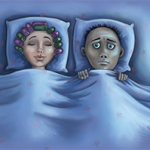Treatment begins with a diagnosis and moves on to education. Dr. Ting said she typically educates patients about sleep hygiene and prescribes physical activity. Exercise is key to reducing the pain response, but it must be graded to be sustainable. Symptom management includes medication as needed for sleep and mood disorders, headaches, irritable bowel syndrome, and other associated symptoms. Pain, however, has proven to be more intransigent. “If I tell [patients] right up front there’s no proven medication, no quick fix for their pain, I’m going to lose them immediately,” Dr. Ting says. “They’re going to shut down and not listen to a word I say.” Dr. Ting tries to bring up pain treatments and their limited effect last in the discussion.
Dr. Ting also suggested treading carefully around psychological issues, because many patients have been told that the condition is purely psychological. But she also suggested consulting with psychologists or psychiatrists early in the process, if necessary, given the potential effectiveness of CBT. Patients may be receptive to the idea that there are coping skills and distraction techniques to help them deal with the pain. Finally, she urged physicians to inform the patient’s school of the diagnosis.
Daily and Long-Term Impacts
JFM can have a dramatic impact on daily life, noted Dr. Kashikar-Zuck. Her team conducted a sociometric study that found that the patients and their peers perceived patients with JFM as more socially isolated and less well liked than others. In another study of family life, she found that JFM patients had poorer family functioning and more conflicted family relationships. (Mothers also reported twice as many pain conditions and were five times more likely to have fibromyalgia.) In a third study, she found a strong association between JFM and anxiety, mood, and behavioral disorders. Fifty-seven percent met the criteria for at least one anxiety condition, 41% reported mood disorders, and more than 20% had a behavioral diagnosis.
The long-term outcomes for adolescents with JFM are not well studied. Community-based studies tend to show that individuals with chronic widespread pain improve over time, while clinical studies have found that the majority of JFM patients show a less positive prognosis. Dr. Kashikar-Zuck is following a cohort of adolescents diagnosed in her clinic through young adulthood. In a Web-based questionnaire of patients who had been diagnosed three to four years earlier, 60.7% reported that they continued to experience all the cardinal features of fibromyalgia. More than 70% reported some of the cardinal symptoms. (The study has been accepted for publication in Rheumatology.)
CBT and Coping
CBT has been shown to be useful for pain management in adult chronic pain conditions, Dr. Kashikar-Zuck says, and shows promise in the treatment of pediatric chronic pain. CBT teaches self-management and coping skills to reduce disability, distress, and pain.
